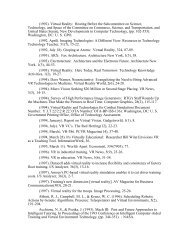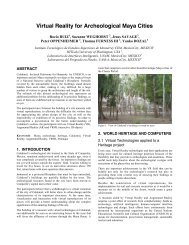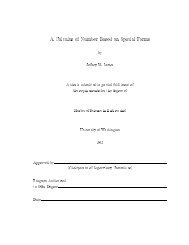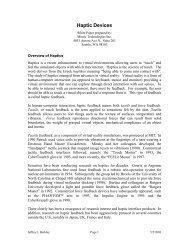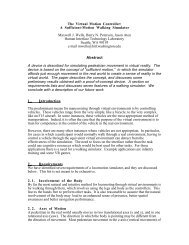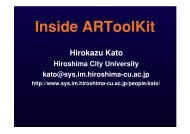Fall.Winter 95 - HITL Home - University of Washington
Fall.Winter 95 - HITL Home - University of Washington
Fall.Winter 95 - HITL Home - University of Washington
Create successful ePaper yourself
Turn your PDF publications into a flip-book with our unique Google optimized e-Paper software.
HumanFactors/InterfacePhoto: George SteinmetzForeground/BackgroundManipulations Affect PresenceThere is a trade-<strong>of</strong>f between widefield-<strong>of</strong>-view (FOV) and high resolutionin immersive HMDs. It isgenerally believed that a wide FOV isnecessary to stimulate a sense <strong>of</strong>presence, <strong>of</strong> “being in” a virtualenvironment. Since a sense <strong>of</strong>presence is regarded as crucial formany tasks, a difficult choice is <strong>of</strong>tenmade between increasing HMD FOVor decreasing FOV to allow for betterresolution.In a paper appearing in the 19<strong>95</strong>Human Factors and ErgonomicsSociety (HFES) Conference Proceedings,<strong>HITL</strong> researchers JerryProthero, Hunter H<strong>of</strong>fman, DonParker, Tom Furness and Max Wellsreport on experiments which suggestit is possible to alter the level <strong>of</strong>presence in a virtual environment at aconstant FOV simply by manipulatinghow the scene boundary is perceived.This research resulted from the ideathat presence is an illusion <strong>of</strong> perceivedself-position and as such isclosely related to vection (the illusion<strong>of</strong> perceived self-motion caused byvisual stimuli). If presence andvection are closely related, one wouldexpect to be able to take results fromthe vection literature and apply themto manipulating levels <strong>of</strong> presence.Vection research has indicated thatone’s perceived motion is heavilyinfluenced by the relative motionbetween one’s self and what oneperceives to be the background (evenif it is the background which isactually moving). Providing a screenwith a wide FOV is one way toencourage users to interpret the sceneas background, and thus to feelvection. Another approach, at givenFOV, is to put the boundary <strong>of</strong> thescene in front <strong>of</strong> the scene content. Inthis way, the user may unconsciouslybelieve that the scene is much largerthan it is, meaning that it may beinterpreted as background (and thereforeinduce vection).In the experiments reported on in theHFES paper, it was shown that thesame trick can be used to induce ahigher sense <strong>of</strong> presence at a givenFOV, comparing a foreground occlusion(tanning goggles - see image <strong>of</strong>Prothero above) with a paper occlusiondirectly on the HMD screen.Possible applications are increasingpresence in HMDs by obscuring thescreen boundary with a foregroundocclusion, or decreasing presence(which may reduce simulator sickness)by putting the screen boundaryin the background and emphasizing it.For more information contact:Jerry Prothero, (206) 616-1470prothero@hitl.washington.eduRESEARCH AT THE HUMAN INTERFACE TECHNOLOGY LABORATORY 15



